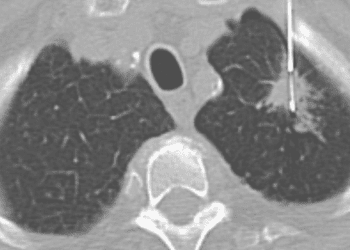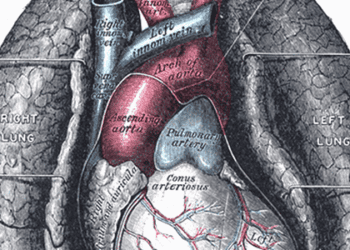Chest radiograph neural network predicts lung cancer in smokers
1. A deep-learning network using chest radiographs and basic demographic information was able to predict lung cancer incidence similar to other high performing models
2. The model also predicted lung cancer deaths with similar accuracy to other high performing models
Evidence Rating Level: 3 (Average)
Study Rundown: Lung cancer screening had been shown to improve mortality in select high-risk smoking populations. The current eligibility criteria for lung cancer screening misses most lung cancers and the estimated participation of five percent is abysmal compared to other screening programs. The authors developed a convolutional neural network, a form of artificial intelligence, to predict lung cancer incidence based on chest radiographs, age, sex and current smoking status termed the CXR-LC Risk Score. The training and validation dataset came from U.S. lung cancer screening trials. The model was superior in both detecting incident lung cancers and lung cancer mortality than current clinical criteria for lung cancer screening and comparable to the Modified PLCO Lung-Cancer Risk Prediction Model (PLCOM2012), a high performing prediction model. The CXR-LC model had higher sensitivity for detecting lung cancer and a net benefit for screening when compared to the current clinical criteria. Several factors limited the application of this study. For example, the data source was mostly non-Hispanic whites which prevented the generalization to other more diverse demographics. Furthermore, as the training set did not include non-smokers, this model also would not apply to non-smokers. In summary, this study demonstrated that a deep-learning network based on electronic health data is comparable to current high performing models without smoking history as an input.
Click here to read the study, published today in Annals of Internal Medicine
Relevant Reading: Selection Criteria for Lung-Cancer Screening
In-Depth [retrospective cohort]: This study trained a neural network using the PLCO (Prostate, Lung, Colorectal and Ovarian) Cancer Screening Trial (n = 41,856) and validated in the NLST (National Lung Screening Trial) and PLCO smokers (n = 11,108). The model inputs included chest radiograph, age, sex and current smoking status and the outcome measure was the 12-year lung cancer incidence. The CXR-LC had a better area under the receiver-operating characteristic curve (AUC) for lung cancer incidence compared to the current clinical criteria (≥30 pack-years and ≤15 years since quitting) for lung cancer screening (AUC 0.755 vs. 0.634, p < 0.001) and similar to the PLCOM2012 (AUC 0.755 vs. 0.751 for one dataset, and 0.659 vs. 0.650 for another). CXR-LC had higher sensitivity compared to clinical criteria (74.9% vs. 63.8%, p = 0.012). For lung cancer mortality, CXR-LC was superior to clinical criteria (AUC 0.762 vs. 0.638, p < 0.001) and similar to PLCOM2012 (0.762 vs. 0.768, p = 0.78). Using decision curves across risk thresholds (1.3-2% for 6-years, 2-5% for 12-years), CXR-LC had a higher net benefit compared to clinical criteria but similar to PLCOM2012. The CXR-LC dataset correlated to increased smoking pack-years and imaging heat maps localized to mid and upper lungs, which are common areas of anatomical changes with emphysema and smoking.
Image: PD
©2020 2 Minute Medicine, Inc. All rights reserved. No works may be reproduced without expressed written consent from 2 Minute Medicine, Inc. Inquire about licensing here. No article should be construed as medical advice and is not intended as such by the authors or by 2 Minute Medicine, Inc.





